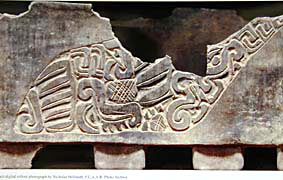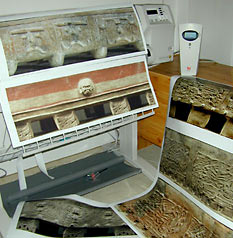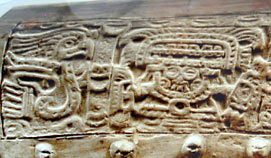The corpus of photographs of Tiquisate pottery is one of the strong points within the FLAAR Photo Archive. Over the last several years we have done extensive rollouts of Tiquisate vases.
Here we show a Tiquisate pot recently photographed, not so much for the information on style, method of carving, but rather to demonstrate the print quality possible from the new generation of color laser printers.
 |
|---|
The scene here is a carved version of what is rendered on painted pottery as the Diagonal Swirl Monster (see FLAAR monograph circa 1985 on cylindrical tripods, www.maya-art-books.org, authored by Nicholas Hellmuth).
Since the pot is broken it has no sales value, a photographer would unlikely be inspired to do a rollout photograph of it. But the FLAAR program of rollout photographs is to record archaeological information. Since we do not buy and sell these pots we do not care whether they are "pretty" or not.
The diagonal arrangement of the design field is typical of Early Classic cylindrical tripods in general and Tiquisate cylindrical tripods in particular.
 |
|---|
Printed at 11x17 inch size on First Choice paper supplied courtesy of Weyerhaeuser on a T8204 color laser printer from Tally. This color printshows every detail of the ancient pot.
More Tiquisate cylindrical tripods photographed by the FLAAR Photo Archive. (Right picture)
Top left: the Tiquisate Trinity but pictured on a tripod possibly from the Maya Lowlands. The Tiquisate Trinity is found throughout Mesoamerica, especially in the Central Peten area.
Middle left: red and cream, a common color for Early Classic Tiquisate. This style, however, has not often been published.
Right top: frontal goggle eyed warrior figure; right middle and bottom, two examples of a standard Tiquisate ballgame decapitation scene. These particular pots, however, were not photographed in time for inclusion in the FLAAR publication on the Tiquisate ballgame series (Hellmuth, circa 1987). Details are pictured in the next set of pictures, below on this web page.
Wide format printer is courtesy of Hewlett-Packard, an HP DesignJet 2800 CP, 36 inches wide. This enlarged size is the easiest way to study the rollouts. Imagine how easy teaching would be if every professor had a wide format printer in his archaeology lab or office.
 |
Above, close-up of goggled Tlaloc-like warrior. The same mold-design is known from a giant cylindrical tripod in the Museo Popol Vuh. The one shown here is from a licensed (registered) private collection, Guatemala). At the right, two Tiquisate ballgame decapitation scenes. Since these scenes were made with a mold-like or stencil-like pattern, they were mass produced in ancient times.
|
|---|---|
 |
These are color digital prints, on bond paper (not fancy expensive photo paper), printed by a Hewlett Packard large format inkjet printer (36 inches wide; the paper is in rolls 100 feet long).
|
 |
Fat character, the first time found on a cylindrical tripod from the Tiquisate area. This character is similar to the fat characters which decorate Late Classic Puuc architecture of Yucatan. The Early Classic example from Tiquisate is probably inspired from Teotihuacan.
|
|
Related links
|
|
|
Volunteer opportunities to study Maya iconography directly with ancient Maya art in Guatemalan museums
|
Gateway to dozens of unpublished rollout photographs
|
|
Even more links to Maya art and archaeology from another web site, www.maya-art-books.org
|
Desktop publishing (how best to print your reports, class notes, publish in your own office)
|































